Peppermint tea is a caffeine-free herbal tea that has been used for centuries for its refreshing taste and potential health benefits. It is made from the leaves of the peppermint plant, which contains a high concentration of menthol, a compound that gives the tea its characteristic cooling and soothing effect.
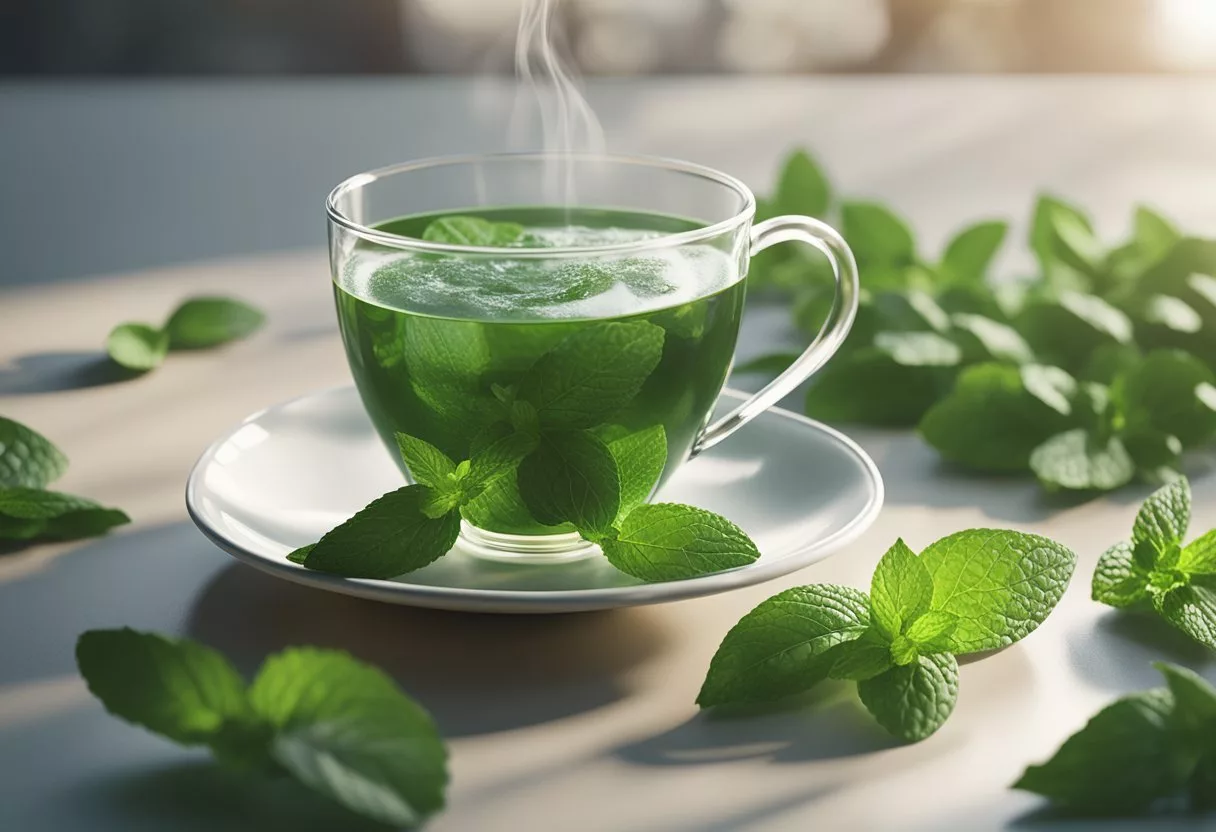
Peppermint tea is commonly consumed for its potential health benefits, which include improving digestion, reducing nausea, and relieving headaches. It is also believed to have antibacterial and anti-inflammatory properties, making it a popular choice for those looking to support their overall health and wellness.
Despite its popularity, there is still much to learn about peppermint tea. This article will explore the potential health benefits of peppermint tea, its nutritional profile, how to brew and use it, and any safety concerns or side effects. It will also compare peppermint tea to other types of tea and explore its culinary and alternative uses, as well as its environmental and economic factors.
Key Takeaways
- Peppermint tea is a caffeine-free herbal tea made from the leaves of the peppermint plant, which contains a high concentration of menthol.
- Peppermint tea has potential health benefits, including improving digestion, reducing nausea, and relieving headaches, and is believed to have antibacterial and anti-inflammatory properties.
- This article will explore the potential health benefits of peppermint tea, its nutritional profile, how to brew and use it, and any safety concerns or side effects, as well as its comparative analysis, culinary and alternative uses, and environmental and economic factors.
What Is Peppermint Tea?
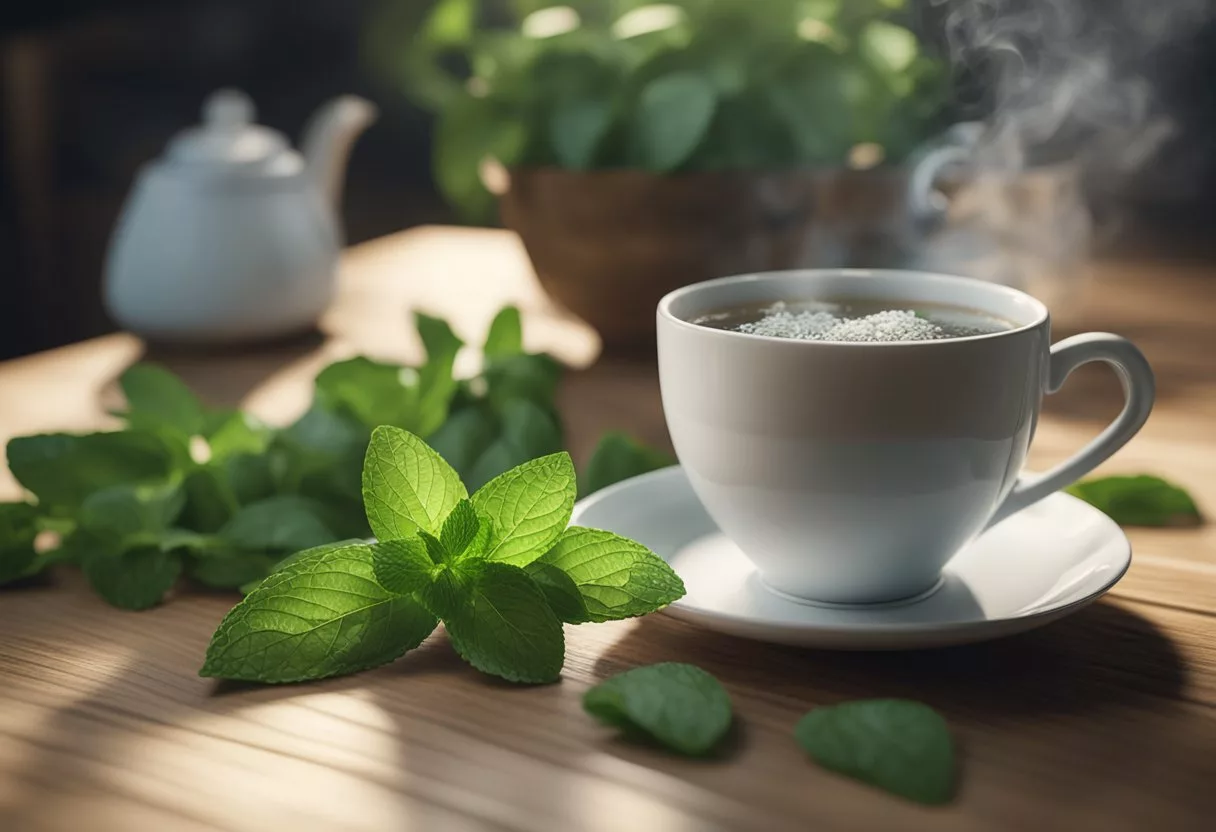
Peppermint tea is an herbal tea made from the leaves of the peppermint plant, scientifically known as Mentha piperita. It is a popular tea variety that is consumed worldwide for its refreshing taste and numerous health benefits. This section will explore the origins and botany of peppermint, the difference between peppermint and spearmint, and the various preparation methods of peppermint tea.
Origins and Botany
Peppermint is a hybrid plant that is believed to have originated in Europe. It is a member of the mint family, which also includes other popular herbs such as spearmint, watermint, and basil. Peppermint is a perennial plant that can grow up to 3 feet tall and has a square stem with dark green leaves. The leaves of the peppermint plant contain essential oils that give it its characteristic aroma and flavor.
Peppermint vs. Spearmint
Peppermint and spearmint are two of the most popular mint varieties used in teas and other culinary applications. While they both belong to the same mint family, they have some distinct differences. Peppermint has a stronger flavor and aroma than spearmint, and its leaves contain a higher concentration of menthol, which gives it its cooling effect. Spearmint, on the other hand, has a sweeter and milder taste and is often used in desserts and cocktails.
Preparation Methods
Peppermint tea can be prepared using fresh or dried peppermint leaves. To prepare the tea, the leaves are steeped in hot water for a few minutes, after which the leaves are strained out. Peppermint tea can be consumed hot or cold, and it is often sweetened with honey or sugar. Peppermint tea can also be blended with other herbs such as chamomile, lemon balm, or ginger to create unique flavor profiles.
Health Benefits of Peppermint Tea
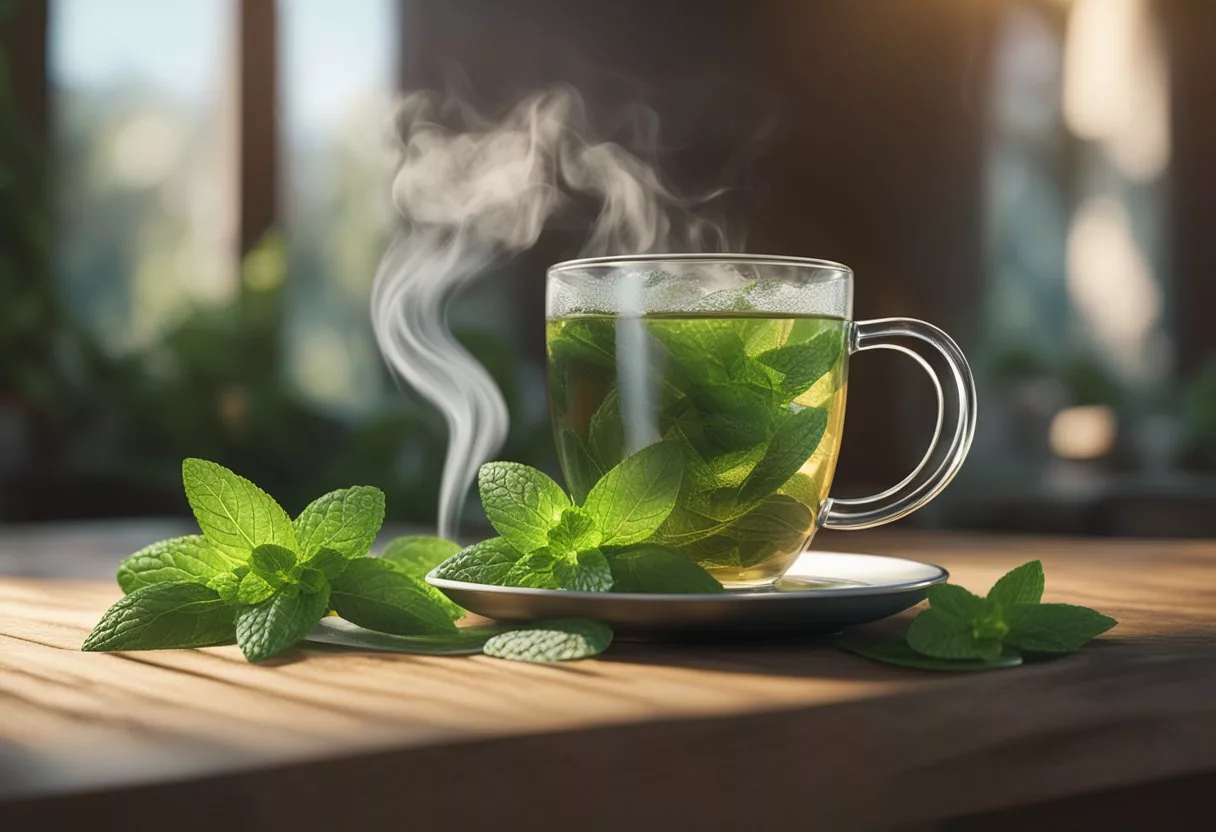
Peppermint tea has been consumed for centuries and is known for its refreshing taste and aroma. It is made by steeping peppermint leaves in hot water. Peppermint tea is also known for its numerous health benefits, which are backed by scientific research. In this section, we will explore some of the health benefits of peppermint tea.
Digestive Health
Peppermint tea is known for its ability to improve digestive health. It has been found to be effective in treating gastroesophageal reflux disease (GERD) and irritable bowel syndrome (IBS) [1]. Peppermint tea has anti-inflammatory properties that can reduce inflammation in the gut. It also has antispasmodic properties that can help to relax the muscles in the digestive tract, reducing cramping and bloating.
Respiratory Benefits
Peppermint tea has been found to have respiratory benefits. It has been shown to have antibacterial, antiviral, and anti-inflammatory properties, which can help to relieve congestion and coughs associated with cold and flu. The menthol in peppermint tea can also help to soothe the throat and reduce inflammation.
Pain Relief
Peppermint tea has also been found to have pain-relieving properties. It can help to relieve headaches and migraines due to its muscle relaxant and pain-relieving properties. It can also help to relieve menstrual cramps and other types of pain.
Mental Wellbeing
Peppermint tea can also have a positive impact on mental wellbeing. It has been found to increase alertness, focus, and energy levels. It can also help to reduce stress and anxiety due to its calming effects.
Nutritional Profile
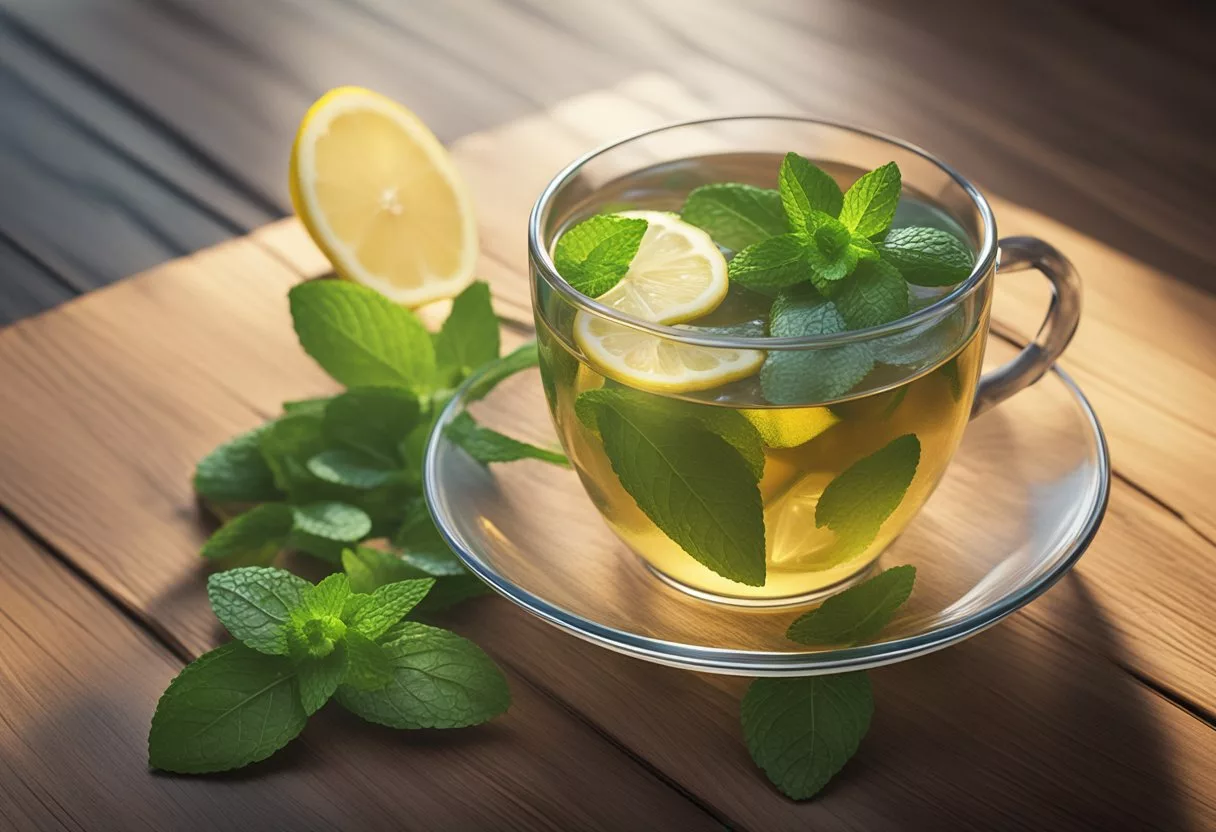
Peppermint tea is a refreshing and flavorful beverage that offers several health benefits. This tea is made by steeping peppermint leaves in hot water. It contains several essential vitamins and minerals that are beneficial for the body.
Vitamins and Minerals
Peppermint tea is a good source of vitamins and minerals. It contains vitamins A and C, which are essential for maintaining healthy skin and immune function. It also contains small amounts of calcium, magnesium, and potassium, which are important for maintaining healthy bones and muscles.
Caloric Content
Peppermint tea is virtually calorie-free, making it an excellent choice for those who are watching their weight. One cup of peppermint tea contains only 2 calories. This makes it a great alternative to sugary beverages like soda and juice.
Peppermint tea also contains antioxidants like rosmarinic acid and flavonoids, which can help protect the body against damage from free radicals. These antioxidants may also have anti-inflammatory properties, which can help reduce inflammation in the body.
Brewing and Usage

Steeping Techniques
Peppermint tea can be brewed using either tea bags or loose leaves. For a single serving, use one tea bag or one teaspoon of loose leaves per cup of water. Bring fresh water to a boil and then let it cool for a few minutes until it reaches a warm temperature. Pour the warm water over the tea bag or loose leaves in a teapot or cup and let it steep for 3-5 minutes. Steeping for too long can make the tea bitter, so it is important to keep an eye on the time.
For a stronger brew, use more tea bags or leaves and steep for a longer period of time. Some people prefer to use a French press or infuser to steep loose leaves, as it allows for a more even distribution of the tea leaves and easier removal.
Serving Suggestions
Peppermint tea can be enjoyed hot or cold. For a warm cup of tea, add honey or sugar to taste. Peppermint tea can also be used as a base for other drinks, such as a peppermint latte or peppermint hot chocolate.
For a refreshing iced tea, let the tea cool to room temperature and then pour over ice. Add a squeeze of lemon or lime for an extra burst of flavor. Peppermint tea can also be used to make popsicles or other frozen treats.
Safety and Side Effects
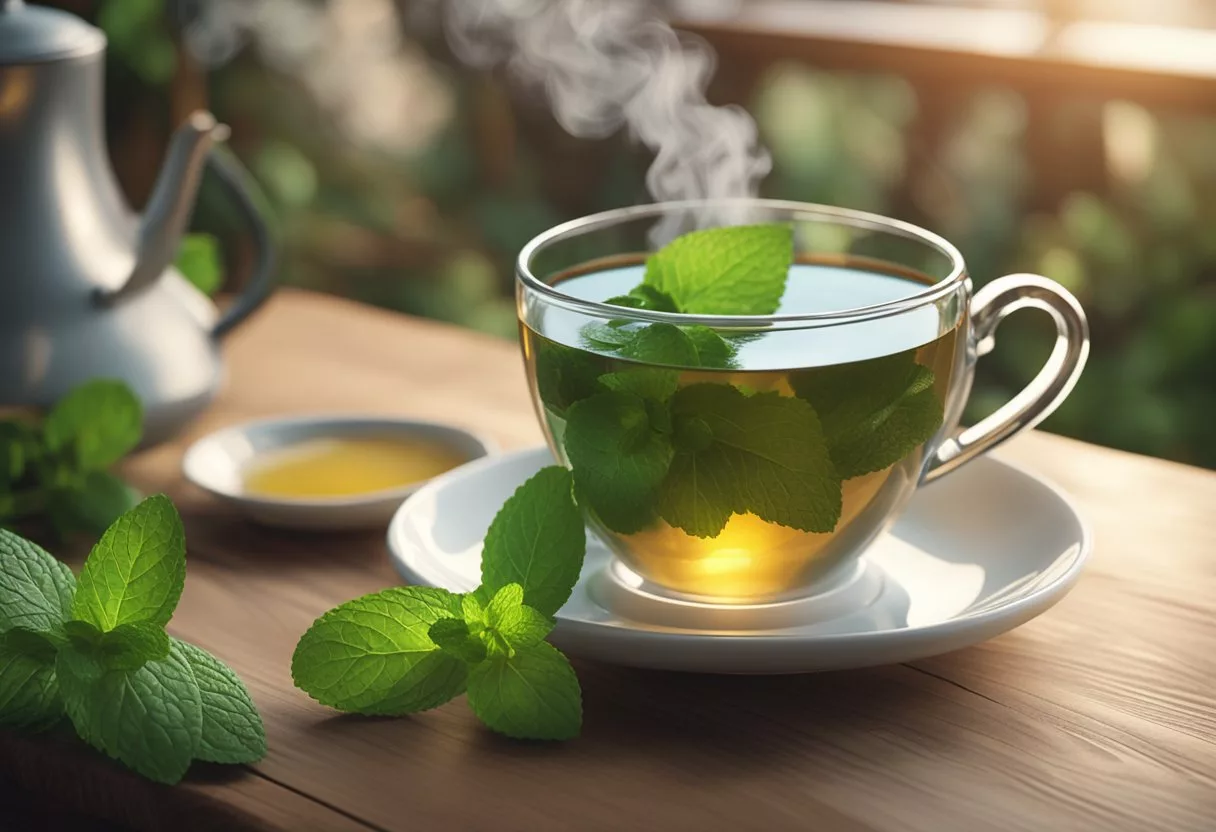
Common Concerns
Peppermint tea is generally considered safe when consumed in moderate amounts. However, excessive consumption of peppermint tea may lead to certain side effects such as heartburn, nausea, vomiting, and diarrhea. According to a report by Livestrong, peppermint oil can be toxic and even deadly if taken in excess amounts. Therefore, it is important to follow the recommended dosage and consult with a healthcare provider before consuming peppermint tea or supplements.
In addition, individuals with gastroesophageal reflux disease (GERD) or hiatal hernia should avoid consuming peppermint tea as it may worsen their symptoms. Peppermint tea may also cause allergic reactions in some individuals. If you experience symptoms such as swelling, itching, or difficulty breathing after consuming peppermint tea, seek medical attention immediately.
Interactions with Medications
Peppermint tea may interact with certain medications. These include those for high blood pressure, diabetes, and acid reflux. Peppermint tea may lower blood pressure and blood sugar levels. It may also increase the absorption of medications such as cyclosporine. Cyclosporine is a drug used to prevent organ rejection after a transplant.
Therefore, individuals taking medications should consult with their healthcare provider. This is to avoid potential interactions. Pregnant and breastfeeding women should also consult with their healthcare provider. This is because there is limited research on its safety during pregnancy and lactation.
Comparative Analysis
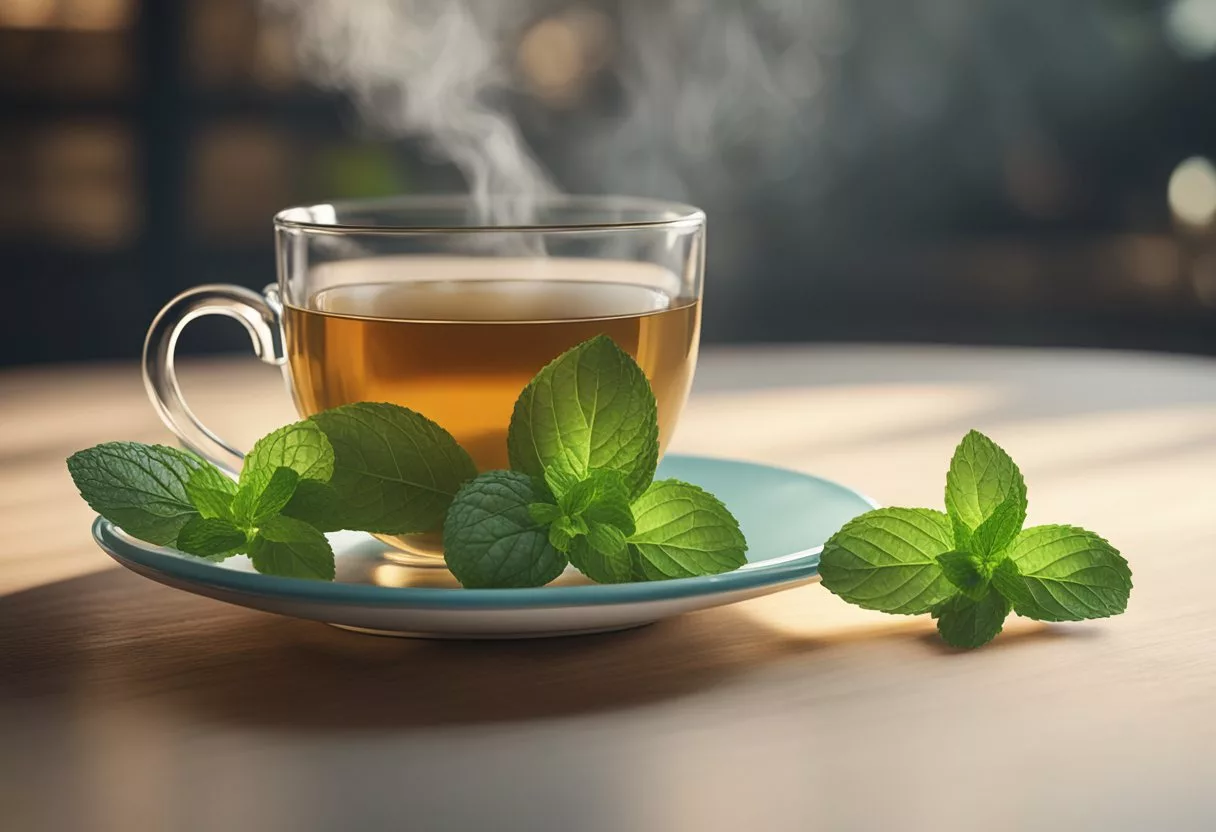
Peppermint Tea vs. Other Herbal Teas
Peppermint tea is a popular herbal tea that is consumed around the world. It is made by steeping dried peppermint leaves in hot water. Peppermint tea has a refreshing taste and aroma, and it is known for its numerous health benefits. But how does peppermint tea compare to other herbal teas?
When it comes to flavor, peppermint tea has a strong and refreshing taste that is distinct from other herbal teas. Some other popular herbal teas include chamomile, ginger, and hibiscus.
Chamomile tea has a mild, floral taste and is known for its calming properties. Meanwhile, ginger tea has a spicy and warming taste and is often used to soothe upset stomachs. Lastly, hibiscus tea has a tart and fruity taste and is high in antioxidants.
In terms of health benefits, peppermint tea is known for its ability to soothe digestive issues, such as bloating, gas, and indigestion. It is also believed to have anti-inflammatory and pain-relieving properties.
Chamomile tea is known for its calming and sleep-inducing properties. Meanwhile, ginger tea is often used for its anti-nausea and anti-inflammatory effects. Lastly, hibiscus tea is high in vitamin C and antioxidants, which can help boost the immune system and protect against chronic diseases.
Caffeinated vs. Caffeine-Free Teas
Peppermint tea is a caffeine-free herbal tea, which means it does not contain any caffeine. Caffeine is a natural stimulant found in many types of tea, including black tea, green tea, and oolong tea. Caffeine can provide a temporary boost of energy and alertness, but it can also cause jitters, anxiety, and disrupted sleep.
Caffeine-free herbal teas, such as peppermint tea, are a great alternative for those who are sensitive to caffeine or who want to avoid it for other reasons. Caffeine-free herbal teas can still provide numerous health benefits, such as improved digestion, reduced inflammation, and increased relaxation.
Culinary and Alternative Uses
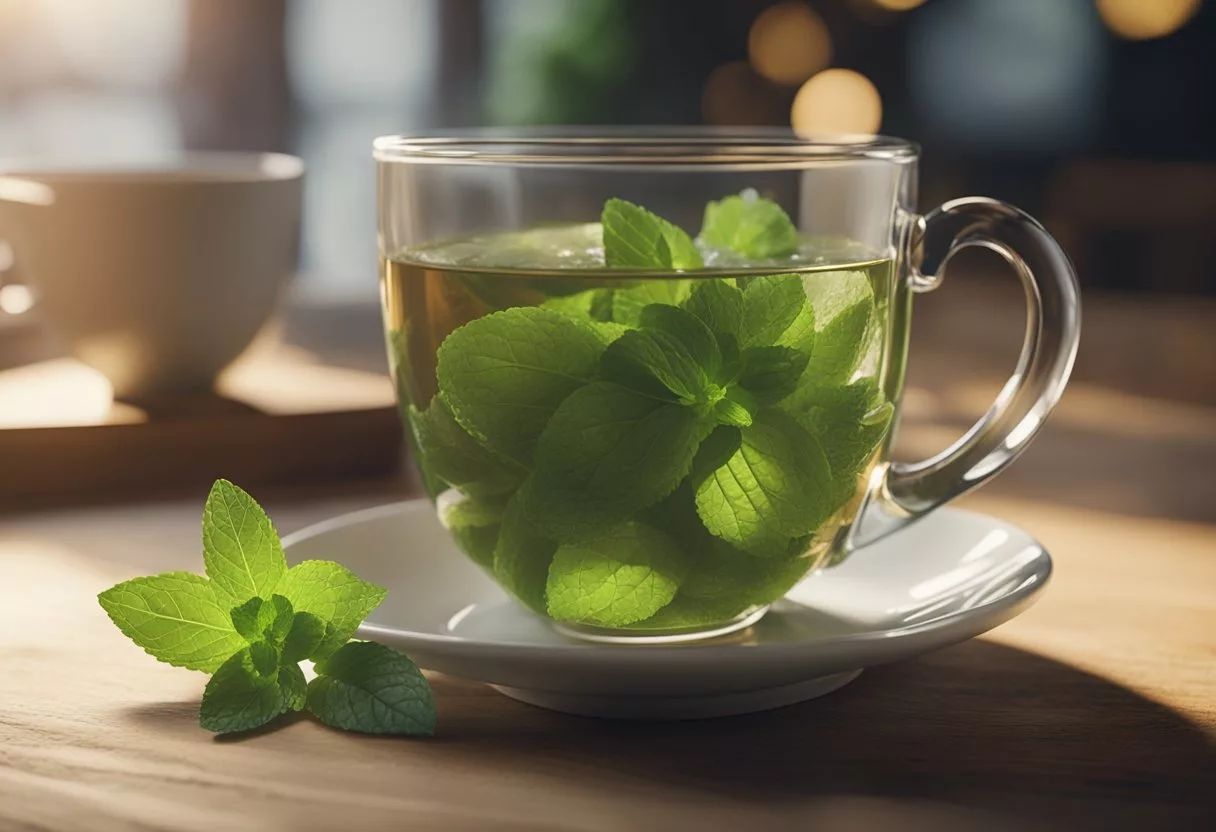
In Cooking
Peppermint tea is not just for drinking. Its refreshing flavor and aroma make it a versatile ingredient in cooking and baking. Peppermint extract is commonly added to baked goods such as cookies, cakes, and brownies to give them a minty twist. It can also be used to flavor homemade ice cream, frosting, and hot chocolate.
For a stronger peppermint note, one may substitute brewed peppermint tea. This alternative is particularly useful in recipes like peppermint tea and minty iced beverages.
Aromatherapy and Essential Oils
Peppermint oil is a popular essential oil used in aromatherapy due to its invigorating and refreshing scent. It is believed to help ease tension headaches, improve mental clarity, and boost energy levels.
In addition to its use in aromatherapy, peppermint oil is also used in various products such as shampoos, soaps, and lotions. It is also used as a natural insect repellent.
When using peppermint oil for aromatherapy or other purposes, it is important to dilute it properly. This is to avoid skin irritation or other adverse effects. It is recommended to use a carrier oil such as jojoba oil or coconut oil to dilute peppermint oil before use.
Environmental and Economic Factors

Sustainable Cultivation
Peppermint tea is made from the leaves of the peppermint plant, which is a perennial herb that grows well in a variety of climates. Peppermint is known for its strong aroma and refreshing taste, which makes it a popular choice for tea drinkers. However, there are environmental and economic factors to consider when cultivating peppermint for tea production.
Peppermint is a hardy plant that requires little maintenance, making it an attractive crop for farmers. However, the use of pesticides and fertilizers can have negative environmental impacts. To ensure sustainable cultivation, farmers can use organic farming practices and crop rotation. These practices help maintain soil health and reduce the use of harmful chemicals.
Market Trends
Peppermint tea has gained popularity in recent years due to its health benefits and refreshing taste. The global demand for herbal tea is expected to increase in the coming years, which presents an opportunity for farmers to increase their profits by growing peppermint.
The economic benefits of peppermint tea cultivation extend beyond the farmers. The production and distribution of peppermint tea creates jobs and contributes to the economy. Additionally, the use of sustainable cultivation practices can attract environmentally conscious consumers, which can increase demand for the product.
Frequently Asked Questions

What are the health benefits of drinking peppermint tea?
Peppermint tea offers various health benefits, including aiding digestion, easing stomach issues, and providing a refreshing taste. It is also known to help reduce stress and anxiety levels, improve brain function, and boost the immune system. Additionally, peppermint tea has anti-inflammatory and antibacterial properties that can help prevent and treat infections.
Can peppermint tea cause any side effects?
While peppermint tea is generally considered safe for most people, excessive consumption may potentially lead to some negative effects. Some people may experience heartburn, headaches, and allergic reactions to peppermint. Moreover, peppermint tea may interact with certain medications, such as those used to treat high blood pressure, and should be avoided by pregnant women.
Are there any warnings associated with consuming mint tea?
Mint tea should be consumed in moderation, as excessive intake may lead to negative effects. It is recommended to consult a doctor before consuming mint tea if you have any underlying medical conditions or are taking any medications. Additionally, people with gastroesophageal reflux disease (GERD) or hiatal hernia should avoid mint tea, as it may worsen their symptoms.
How does peppermint tea contribute to skin health?
Peppermint tea has anti-inflammatory and antioxidant properties that can help improve skin health. It can help reduce inflammation, redness, and irritation, and prevent acne breakouts. Moreover, peppermint tea can promote collagen production, which can help reduce the appearance of fine lines and wrinkles.
Does peppermint tea aid in weight loss, and if so, how?
Peppermint tea can aid in weight loss by suppressing appetite, promoting digestion, and increasing metabolism. It can help reduce cravings and prevent overeating, leading to a reduction in calorie intake. Additionally, peppermint tea can help improve digestion and increase the rate at which the body burns calories.
How often can peppermint tea be consumed safely?
Peppermint tea can be consumed safely in moderation. It is recommended to limit intake to 2-3 cups per day.
Also, avoid consuming peppermint tea before bedtime, as it may interfere with sleep. Pregnant women and people with medical conditions should consult a doctor before consuming peppermint tea.